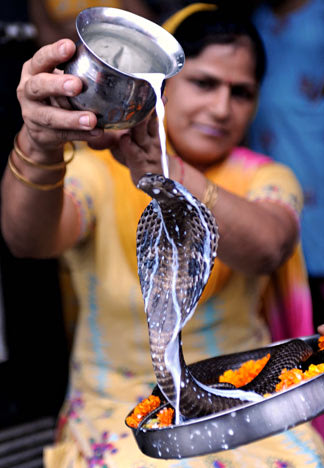prasad1
Active member
"Ahimsa Paramo Dharma" (अहिंसा परमो धर्मः ) : great theory
In our personal life we may live by this philosophy, but should we take it a step further. Some of our religious practice is very cruel, should we actively participate to end such practice?
One in perticular: Nag Panchami.

Nag Panchami and more popularly as Nagula Panchami in Telangana.It is an important Hindu festival celebrated in most parts of India and Nepal. The festival falls on the auspicious day of Shravana Shukla Panchami that is the fifth day of the first half, Moonlit fortnight of Shravana Masam (means the month of Shravana). Naga means Cobra and the festival is called as Naga Panchami as this festival is all about worship of Snakes on the fifth day of Shravana Masam.
Several organizations like PETA – People for the Ethical Treatment of Animals are trying their best to educate people that the Snake charmers who pick up Snakes on the occasion of Nagula Panchami torture them by extracting the venom by cruel methods, stitching their mouths, drugging them, not feeding them and keeping them trapped in tiny baskets. And that the process of worship by offering milk actually chokes the Snake and that the Kumkuma (Vermilion) and Turmeric powder sprinkled on its hood would blind it. Despite such appeals to prevent cruelty, a majority of the population go by the traditions set by their parents and ancestors.
In our personal life we may live by this philosophy, but should we take it a step further. Some of our religious practice is very cruel, should we actively participate to end such practice?
One in perticular: Nag Panchami.

Nag Panchami and more popularly as Nagula Panchami in Telangana.It is an important Hindu festival celebrated in most parts of India and Nepal. The festival falls on the auspicious day of Shravana Shukla Panchami that is the fifth day of the first half, Moonlit fortnight of Shravana Masam (means the month of Shravana). Naga means Cobra and the festival is called as Naga Panchami as this festival is all about worship of Snakes on the fifth day of Shravana Masam.
Several organizations like PETA – People for the Ethical Treatment of Animals are trying their best to educate people that the Snake charmers who pick up Snakes on the occasion of Nagula Panchami torture them by extracting the venom by cruel methods, stitching their mouths, drugging them, not feeding them and keeping them trapped in tiny baskets. And that the process of worship by offering milk actually chokes the Snake and that the Kumkuma (Vermilion) and Turmeric powder sprinkled on its hood would blind it. Despite such appeals to prevent cruelty, a majority of the population go by the traditions set by their parents and ancestors.
